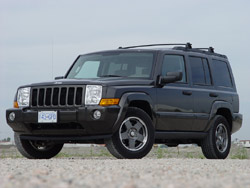 2006 Jeep Commander V6; photo by Greg Wilson. Click image to enlarge |
|
Related links
Manufacturer’s web site |
By Chris Chase
Introduced in 2006, the Jeep Commander was the solution to the lack of a seven-seater SUV in the brand’s line-up. Based on the popular Grand Cherokee, the Commander benefited from that donor vehicle’s generally well-done appointments and was dressed in sheetmetal that bore more than a passing resemblance to that of the dearly-departed Cherokee.
Engine choices mirrored those of the Grand Cherokee, starting with a 3.7-litre V6 (210 hp/235 lb.-ft.), moving up through a 4.7-litre V8 (235 hp/305 lb-ft) to the range-topping 5.7-litre Hemi V8 (330 hp/375 lb.-ft.). In 2009, the 4.7-litre engine was redesigned and gained 70 horsepower for 305 total and 334 lb-ft of torque. The Hemi V8 also got variable valve timing and boosted output to 357 hp and 389 lb.-ft.
All three engines were paired with a five-speed automatic transmission that was in turn bolted to one of three four-wheel drive systems: Quadra-Trac I (no low range, full-time four-wheel drive); Quadra-Trac II (full-time active 4WD with electronically-selectable low-range gearing) and Quadra-Drive II (low-range gearing, and electronic limited-slip front, centre and rear differentials).
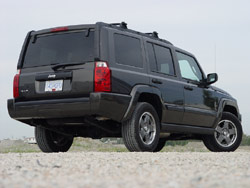 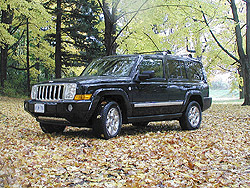 2006 Jeep Commander V6 (top, by Greg Wilson) and 5.7-litre, by Grant Yoxon. Click image to enlarge |
Fuel consumption for 2006 models was rated by Natural Resources Canada at 14.8/10.9 L/100 km (all figures listed as city/highway) with the V6, 15.6/10.7 L/100 km for the 4.7-litre V8 and 16.5/11.2 L/100 km with the 5.7-litre engine. The addition of variable valve timing to the 5.7-litre engine helped improve fuel consumption to 15.7/10.6 L/100 km.
Consumer Reports gives the Commander a “much worse than average” used vehicle reliability rating and notes a whole slew of items to watch for, which are detailed below.
Engine stalling has been a problem since shortly after the Commander’s arrival in showrooms as a 2006 model. One cause is a faulty transmission fluid filter that essentially chokes the flow of fluid through the transmission and causes the engine to shut down. Another potential cause is an overly-sensitive ignition switch; knock the keychain with a knee while driving and the switch will move out of the “run” position and shut the engine off. Read this thread for information and anecdotal tales of woe.
A climate control blower that vibrates “as if the bottom is falling out of the truck” is common. The cause is a piece of mastic (sticky stuff, basically) that comes loose from the truck body and gets stuck to the blower, putting it out of balance and making it vibrate like mad. The solution is to take out the blower and, at best, remove the offending foreign object and put the blower back; at worst, the blades of the blower will be damaged and it’ll need to be replaced. Either way, this is a task that can be tackled by a handy owner who wants to avoid an out-of-warranty repair.
Read this thread for information on water leaks from the sunroof and near the top of the windshield/A-pillar. Also, the Commander’s interior door handles and the door panel are brittle and break easily.
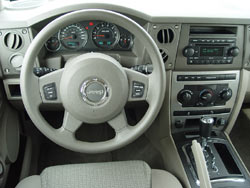 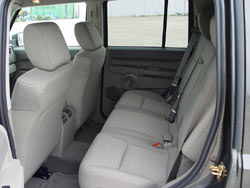 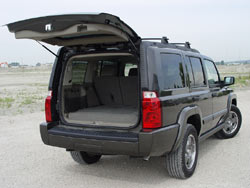 2006 Jeep Commander V6; photos by Greg Wilson. Click image to enlarge |
The Commander’s transmission is notorious for defaulting to “limp-in” mode, wherein its electronic brain locks the transmission in third gear. Three Technical Service Bulletins have been issued, suggesting causes like a bad sensor or a fault in the transmission’s wiring harness. Read all about it in this 15-page, six-year-old thread at JeepCommander.com.
Excessive wind noise at highway speeds is a common problem, caused, depending on who you talk to, by a misaligned piece of windshield weatherstripping or a loose cowl vent cover. Check this thread at JeepForum.com for info.
Power windows that won’t respond to the automatic-up control (rather they do, but only go partway up before retreating into the door) are caused either by a bad window regulator or simply need to be “reset.” Doing so is easy; it’s detailed here.
For more info, click here, here and over here.
A hard shift from Reverse to Neutral is probably caused by a bad front differential bushing. This is a well-known problem with the Grand Cherokee, which shares much of its mechanical make-up with the Commander.
Also, watch for brakes that squeak, wear out prematurely, vibrate/pulsate or all of the above.
The National Highway Traffic Safety Adminstration (NHTSA) gave the Commander five stars for driver and front passenger protection in frontal crash tests, but never tested the truck for side impact safety. The Insurance Institute for Highway Safety (IIHS) never tested the Commander, period. Standard safety kit in Canada included front-seat thorax airbags, head side curtain airbags, anti-lock brakes and traction/stability control.
Commander resale values are fair to middling, with newer models looking like a better deal. A 2010 Sport model optioned with the 4.7-litre V8 is worth about two-thirds of its roughly $43,000 MSRP, and if you go back to 2006, you can find a similar Commander worth about 40 per cent of its original price.
An attractive price is not all that makes for a great deal; the Commander has its share of reliability issues that seem affect all model years. The good news is that most of these problems are well-documented, so between a competent service department and the help of other Commander owners via the Internet, many of these problems should be a one-time fix, if they haven’t already been exorcised by a previous owner. Still, approach any used Commander with caution: insist on a good, long test drive, don’t bother with one that doesn’t come with detailed maintenance and service records, and be sure to get any potential purchase checked by a trusted mechanic before you do the deal.
|
Pricing
Black Book Pricing (avg. retail) September, 2011:
Online resources
Recalls
2006: On certain vehicles, the edge of the seat belt retractor bracket on the third-row seat may contact the seat belt webbing during certain operating conditions. As a result, the seat belt may not properly restrain third-row seat occupants during a crash, increasing the risk of personal injury. Correction: Dealers will install a plastic cover on the retractor bracket at both third-row seating positions.Transport Canada Recall Number: 2006373; Units affected: 5,886 (includes other models) 2007: On certain vehicles, the Anti-lock Brake System (ABS) control module software may cause the rear brakes to lock-up during certain braking conditions. This could result in a loss of vehicle control and cause a crash without warning. Correction: Dealers will reprogram the ABS electronic control unit. Transport Canada Recall Number: 2007299; Units affected: 1,260 (includes other models) 2007-2008: On certain vehicles, the front brake calipers were improperly manufactured and could break under certain operating conditions. This could increase the vehicle’s stopping distance and cause a crash with injury or death. Correction: Dealers will inspect and, if required, replace the front brake calipers. Transport Canada Recall Number: 2007305; Units affected: 30,468 (includes other models) 2006-2007: On certain vehicles, software programmed into the Antilock Brake System (ABS) electronic control module may allow a momentary delay in braking when coasting up a hill during certain conditions. This could cause a crash without warning. Correction: Dealers will reprogram the ABS electronic control module with updated software. Transport Canada Recall Number: 2008042; Units affected: 60 (includes other models) 2008: On certain vehicles, the front control module may have been manufactured incorrectly. This could cause the engine to stall while driving, or not to start, and/or cause the windshield wipers to become inoperative. Engine stalling would result in lost propulsion which, in conjunction with traffic and road conditions, and the driver’s reactions, could increase the risk of a crash. Correction: Dealers will inspect the front control module and replace it if necessary. Transport Canada Recall Number: 2008185; Units affected: 2,009 2006: On certain vehicles equipped with a 4.7L engine, the Powertrain Control Module (PCM) contains software that may allow the engine to stall under certain operating conditions. Engine stalling would result in lost propulsion which, in conjunction with traffic and road conditions, and the driver’s reactions, could increase the risk of a crash. Correction: Dealers will reprogram the PCM. Transport Canada Recall Number: 2009108; Units affected: 350 2009: On certain vehicles, the driver airbag squib wires on the steering column control module (SCCM) may be reversed. As a result, the driver airbag may not deploy as intended which can increase the risk of driver injury or death during a vehicle crash. Correction: Dealers will inspect and, if necessary, replace the SCCM. Transport Canada Recall Number: 2010009; Units affected: 3,514 (includes other models) 2010: On certain vehicles, the brake booster input rod may have been installed without the retaining clip, or in some cases, with an improperly formed retaining clip. Should the input rod separate from the assembly it could lead to a loss of brakes, which could result in a vehicle crash causing property damage, personal injury or death. Correction: Dealers will install or replace the retaining clips. Transport Canada Recall Number: 2010070; Units affected: 216 (includes other models) 2010: Certain vehicles may have been built with an improperly manufactured rear track bar. This could result in noise and reduced vehicle stability, which may cause a crash causing property damage, personal injury or death. Correction: Dealers will inspect and replace affected track bars. Transport Canada Recall Number: 2010151; Units affected: 8,902 (includes other models) 2010: Certain vehicles equipped with automatic transmission may have been built with a Wireless Ignition Node (WIN) module exhibiting a binding condition of the solenoid latch. This may result in a condition where the Ignition key can be removed from the WIN module prior to placing the shifter in PARK. This could result in unintended vehicle movement, which may cause property damage, personal injury or death. Correction: Dealers will inspect and, if necessary, replace the WIN module. Transport Canada Recall Number: 2010273; Units affected: 730 2007-2010: On certain vehicles that were not equipped with a factory sunroof, the supplemental side airbag inflatable curtain may not position properly during inflation. The side curtain airbag will still timely deploy and meet and exceed applicable safety standards. Correction: Dealers will install a bracket and foam block behind the “B” pillar upper trim cover to improve side curtain airbag positioning in the event of a deployment. This action is a Customer Satisfaction Campaign and is not being conducted as per the requirements of the Motor Vehicle Safety Act.
Crash test results
Used vehicle prices vary depending on factors such as general condition, odometer reading, usage history and options fitted. Always have a used vehicle checked by an experienced auto technician before you buy. For information on recalls, see Transport Canada’s web-site, www.tc.gc.ca, or the U.S. National Highway Transportation Administration (NHTSA)web-site, www.nhtsa.dot.gov. For information on vehicle service bulletins issued by the manufacturer, visit www.nhtsa.dot.gov. For information on consumer complaints about specific models, see www.lemonaidcars.com. |











